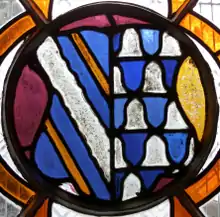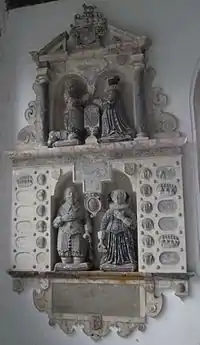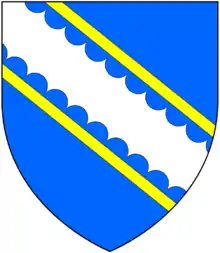John Fortescue (Captain of Meaux)
John Fortescue (died after 1432), of Shepham[2] in the parish of Modbury[3] in Devon, was an English landowner and administrator.[4] He is said in most ancient sources to have been appointed in 1422 by King Henry V as Captain of the captured Castle of Meaux,[5] 25 miles (40 km) north-east of Paris, following the Siege of Meaux during the Hundred Years' War, although this appointment is questioned by Ives (2005).
Origins

He was born in the 1370s, the second son of William Fortescue (died after 1406), of Whympston in the parish of Modbury in Devon (the earliest recorded English seat of the Fortescue family) by his wife Elizabeth Beauchamp, widow of Richard Branscombe and a daughter of Sir John Beauchamp of Ryme in Dorset by his wife Margaret Whalesborough, and a co-heiress of her brother Thomas Beauchamp of Ryme.[5] Elizabeth Beauchamp was of a junior branch of the Beauchamp feudal barons of Hatch Beauchamp in Somerset. Thomas Beauchamp died without issue when his heirs to one moiety each became the descendants of his two sisters,[7] the other of whom was Joane Beauchamp, wife of Sir Robert Challons, from whom the moiety descended to a member of the Carwithan family.[8]
Career

Ives (2005) stated that "he was not a soldier, as historians of the family have claimed, but a local administrator and man of affairs, above all in the service of the Courtenay family", the Earls of Devon.[4] However, older sources state that he was at the Battle of Agincourt (1415) and that he was appointed after the Siege of Meaux in 1422 as captain of the captured Castle of Meaux, returning to England before 1431 and living at Shepham in South Devon.[9]
Marriage and issue
According to Ives (2005),[4] Fortescue's wife was a certain Clarice, whose family name is lost. However according to traditional sources[10][5][9] he married Elinor Norries, daughter and heiress of William Norries[11] (aliter Norreis, Norreys)[2][12] of Norreys in the parish of North Huish[13] in Devon, by his wife a daughter of Roger Colaton.[14] By his wife he had the following issue:[15]
- Sir Henry Fortescue, of Wood in the parish of Woodleigh, Devon, eldest son and heir, Chief Justice of the Common Pleas in Ireland, who married Jane Bozun, daughter of Edmond Bozun of Wood[16] in the parish of Woodleigh.[17] Wood became the seat of his descendants for several generations.[18]
- Sir John Fortescue (d.1479) of Ebrington in Gloucestershire, 2nd son, Lord Chief Justice of England and Wales, ancestor of the present Earl Fortescue of Ebrington, formerly of Castle Hill, Filleigh, and of Weare Giffard both in North Devon.
- Sir Richard Fortescue, 3rd son, ancestor of the Fortescues of Punsborne in Hertfordshire, of Falkborne and of Seldon.[19]
Fortescue monument
On the south wall of the south aisle chapel ("Fortescue Chapel") of the parish church of Weare Giffard in Devon, is affixed a mural monument, erected in 1638[20] by Hugh Fortescue (1592-1661). It is dedicated to three generations of the Fortescue family and mentions the family origins at Whympston and descent from Sir John Fortescue, Captain of Meaux, as follows in Latin:
- Sunt hi ab Joh(ann)e Fortescue Equite Duce castri de Meaux in Gall(ia) sub H(enrico) 5.o (Quinto) oriundi qui praesepia Fortescutorum de Wimeston Devon ortus habuit fil(ium) Joh(ann)em Summum Justic(ium) et Cancell(arium) sub H(enrico) 6.o (Sexto) sepultum Ebertoniae Glocest(ria) Familia quidem perantiqua et etiamnum felici subole propagata sepulti sunt.
Which may be translated as:
- "These arose from John Fortescue, Knight, Captain of the Castle of Meaux in France, arisen under Henry the Fifth, a scion of the Fortescues of Wympstone, Devon. He had a son John, Chief Justice and Chancellor under Henry the Sixth. He was buried at Ebrington in Gloucestershire. Indeed the very ancient family even now is happy with fruitful issue and are buried here".
Notes
References
- Debrett's Peerage, 1968, p.461
- Pole, Sir William (died 1635), Collections Towards a Description of the County of Devon, Sir John-William de la Pole (ed.), London, 1791, pp. 300-301.
- "Conveyance, Shepham Hill, Elderberries, Easter Broadparks, House, Meadow and Holwell in Modbury parish, Devon, 24 acres, consideration: £226; 1) Sir Peter Fortescue of Wood, Devon, Edmund Parker of Boringdon, Devon, esquire", 1671, Plymouth and West Devon Record Office, Ref: 862/226
- Ives, E. W. (October 2005), "Fortescue, Sir John (c.1397–1479)", Oxford Dictionary of National Biography, Oxford University Press, retrieved 17 September 2017
- Vivian, Lt.Col. J.L., (Ed.) The Visitations of the County of Devon: Comprising the Heralds' Visitations of 1531, 1564 & 1620. Exeter, 1895, pp.352–3.
- The stained glass was brought here from Spridleston, as is explained in a manuscript note by Rev. Richard Lane (d.1858) of Coffleet, Vicar of Brixton and owner of Spridleston, as follows: "The windows in the front of the house (i.e. Spridleston) were ornamented with a variety of armorial bearings in painted glass which were taken down a few years since and given to John Inglett-Fortescue late of Buckland Filleigh who placed them in his parish church" (see: File:NotesOn SpridlestonBrixtonDevon ByRevRichardLane Died1858.jpg
- Pole, Sir William (d.1635), Collections Towards a Description of the County of Devon, Sir John-William de la Pole (ed.), London, 1791, p.180
- Pole, p.180
- Clermont, Lord (Thomas Fortescue) (d.1887), History of the Family of Fortescue in all its Branches, 2nd edition London, 1880, p.44
- Vivian, p.352
- Vivian, Lt.Col. J.L., (Ed.) The Visitations of the County of Devon: Comprising the Heralds' Visitations of 1531, 1564 & 1620, Exeter, 1895, p.352, pedigree of Fortescue
- Risdon, Tristram (died 1640), Survey of Devon. With considerable additions. London, 1811, p.179
- Risdon, pp.179-80
- Risdon, Tristram (d.1640), Survey of Devon, 1811 edition, London, 1811, with 1810 Additions, p.179
- Vivian, p.353
- Vivian, p.353
- Risdon, p.181; Pevsner, Nikolaus & Cherry, Bridget, The Buildings of England: Devon, London, 2004, p.920
- Vivian, p.353; the eventual heiress of Wood was Joan Fortescue who married her cousin John Fortescue (d.1587) of Preston, Devon. (Vivian, p.353)
- Vivian, p.353
- Cherry, Bridget & Pevsner, Nikolaus, The Buildings of England: Devon. Yale University Press, 2004. ISBN 978-0-300-09596-8. p.891
